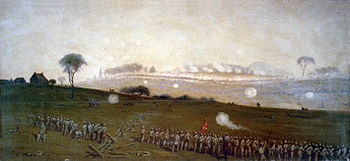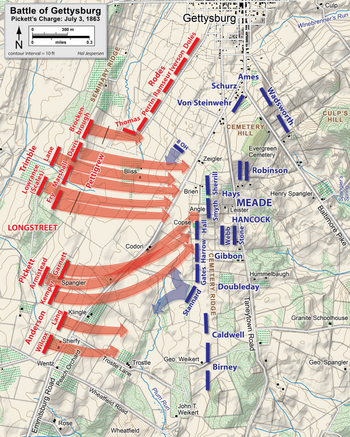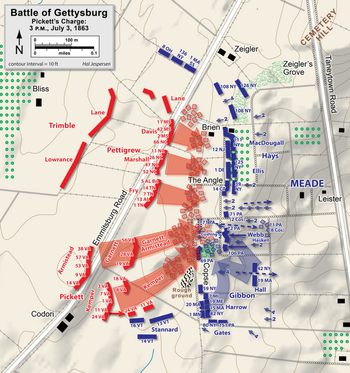| Pickett's Charge | |||||||
|---|---|---|---|---|---|---|---|
| Part of the Battle of Gettysburg | |||||||
 General Pickett's Famous Charge at Gettysburg drawn by Alfred Waud | |||||||
| |||||||
| Belligerents | |||||||
|
|
| ||||||
| Commanders and leaders | |||||||
| Strength | |||||||
|
| ||||||
| Casualties and losses | |||||||
| 1,500 killed and wounded[1] |
| ||||||



Pickett's Charge was an infantry assault on 3 July 1863, during the Battle of Gettysburg. It was ordered by Confederate General Robert E. Lee as part of his plan to break through Union lines and achieve a decisive victory in the North. The charge was named after Major General George Pickett, one of the division commanders under the Confederate Army's command. The assault was aimed at the center of the Union Army's position on Cemetery Ridge, which was believed to be a vulnerable point in the Union defenses. As the Confederate troops marched across nearly a mile of open ground, they came under heavy artillery and rifle fire from entrenched Union forces. The open terrain offered little cover, making the Confederate soldiers easy targets, and their ranks were quickly decimated. Although a small number of the Confederate soldiers managed to reach the Union lines and engage in hand-to-hand combat, they were ultimately overwhelmed. The charge ended in a disastrous defeat for the Confederates, with more than half of the men involved either killed, wounded, or captured. Pickett's Charge marked the climax of the Battle of Gettysburg. The failure of the charge crushed the Confederate Army's hopes of winning a decisive victory in the North and forced General Lee to retreat back to Virginia.
- ^ U.S. War Dept., Official Records, Vol. 27/1, pp. 168–173, 193- General Return of Casualties in the Union forces, commanded by Maj. Gen. George G. Meade, U. S. Army, at the battle of Gettysburg, July 1–3, 1863, pp.168-173
- General Return of Casualties in the Union forces during the Gettysburg Campaign, June 3-August 1, 1863., pp. 193-194